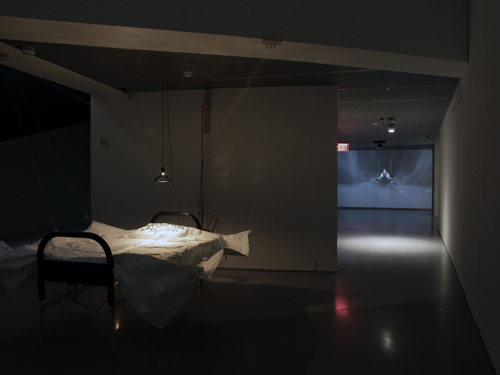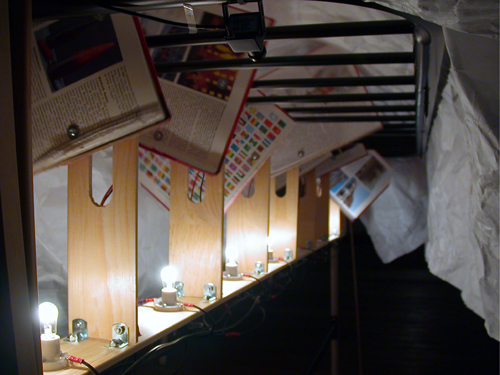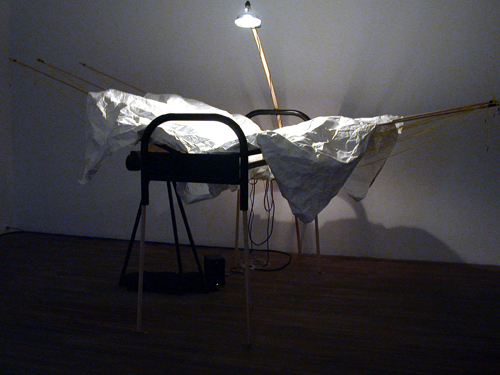





The Magic Shield
2005
sound installation with automation
3 futon-bed frames, motors, selected objects, aluminum, wood, halogen lamp, MIDI controller, computer
3 objects: about 150 x 293 x 358 cm (overall)
work commisionned by Oboro and supported by the Canada Council for the Arts
created during residencies at Oboro’s New Media Lab, Montreal and at Avatar, Quebec City
documentation: – photo & video©Diane Landry
2017
- Équilibre, curator: Claire Lefebvre
, Espace création + exposition | Collège Lionel-Groulx,
Sainte-Thérèse (Quebec, Canada).
2016
- Humanorium - L'étrange fête foraine, curator: Vincent Roy & Ève Cadieux, Parc du Musée, Quebec City (Quebec, Canada).
2013
- Diane Landry: by every wind that blows, Curator: Raphaela Platow & Steven Matijcio, Contemporary Arts Center, Lois & Richard Rosenthal Center for Contemporary Art, Cincinnati (Ohio, USA).
- The Cadence of All Things, Cameron Art Museum, Wilmington (North Carolina, USA).
2010
- Réservoir électrique, Séquence, Saguenay (Quebec, Canada).
- The Defibrillators, curator: Eve-Lyne Beaudry, Mount Saint Vincent University Art Gallery, Halifax (Nova Scotia, Canada).
2009
- The Defibrillators, curator: Eve-Lyne Beaudry,
- Agnes Etherington Art Centre, Kingston (Ontario, Canada);
- Esplanade Art Gallery, Medicine Hat (Alberta, Canada);
- Robert McLaughlin Gallery, Oshawa (Ontario, Canada).
- The Magic Shield, Koffler Gallery at the Beaver Hall Gallery, Toronto (Ontario, Canada).
2008
- Les défibrillateurs, curator: Eve-Lyne Beaudry, Musée d’art de Joliette, Joliette (Quebec, Canada).
2007
- Le Bouclier magique and Le Bouclier perdu, Sporobole, Sherbrooke (Quebec, Canada).
2006
- The Magic Shield, curator: George Harris, Two Rivers Gallery, Prince George (British Columbia, Canada).
- Espace bidules, DSM-V+, dévidoir de syndromes magnifiques, co-organized by Avatar and Folie/Culture and presented at the Musée de la civilisation, Quebec City (Quebec, Canada).
2005
- Le Bouclier magique, Oboro, Montreal (Quebec, Canada).
This project is composed of three futon-bed frames, each draped with a white covering. The covering is a huge crumpled sheet of paper, which lies directly on the structures of the beds. The sheets move about delicately as if each one wished to flee its protective role. Indeed, despite their flimsiness, they serve as protective screens for all kinds of mechanical paraphernalia attached to the very structure of the beds. Under the rib cage of the first futon-bed are some 200 discarded personal keys. This prairie of keys will sometimes stir and metamorphose into a set of chimes. In the innards of the second one are fourteen encyclopedia volumes. These books are moved around by a simple mechanism and create the illusion that two bodies are tossing and turning under the weight of the paper. With the third futon-bed, a large motor drives a cam that makes the whole structure alternate its appearance—from bed to sofa and back again. Underneath this to and fro is a network of ligament-like strings, some taut and some loose, moving in tandem with the moving wings of the bed. The rising and falling give the paper bedcovers an eerie look of weightlessness. The three futon-beds seem to go momentarily from restfulness to wakefulness, from object to event, and from life to death. As Gaby Wood suggests in Edison's Eve, in creating motion, we also evoke the concept of eternity and the consequential precariousness of humans. “Every time an inventor tries to simulate life mechanically, he is in fact accentuating his own mortality. He holds his creation in his hands, and finds, where he expected life, only the lifeless; the closer he comes to attaining his goal, the more impossible it reveals itself to be.”